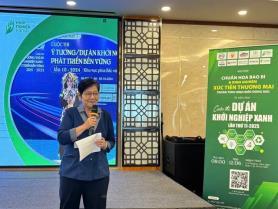In Việt Nam, AI is expected to be adopted across smart buildings, urban transportation and electric vehicle charging infrastructure to enhance energy security.
AI and its applications are making profound inroads into every sphere of production and daily life. It is becoming increasingly vital for the efficient and cost-effective management of the global renewable energy industry by 2030.
In Việt Nam, AI is expected to be adopted across smart buildings, urban transportation, and electric vehicle charging infrastructure to enhance energy security.
The importance of AI in power grid management is rising significantly thanks to its accurate forecasting in smart grid operation, energy demand coordination and distribution, improving power generation efficiency, as well as research and development of new energy materials, according to Đồng Mai Lâm, cluster president for Schneider Electric Vietnam and Cambodia.
AI goes beyond simply alerting about potential issues, damage, or deterioration in systems, energy centres, or power lines that require maintenance and preventive measures. It also integrates this information with data on weather and traffic to assist companies in swiftly and optimally deploying electrical engineers to the field.

“The large amounts of data available on power grid parameters, including generation capacity, loads, currents, voltages, frequencies and grid fault signals, can serve as valuable inputs for various AI applications aimed at enhancing power quality and managing the grid more effectively,” Lâm said.
For example, when it comes to solar power, AI can be used to determine optimal locations for building solar farms based on sunlight duration and intensity. It can also aid operators in strategically planning the layout of solar systems to maximise sunlight capture.
AI technology can also be employed to make automated decisions, enabling solar panels to efficiently track the movement of sunlight throughout the day.
Given Việt Nam’s commitment at COP26 in 2021 to achieve net-zero emissions by 2050, the development of electric vehicles has also become crucial. Transportation contributes around 30 per cent of the country's greenhouse gas emissions, according to the 2022 report by the Ministry of Natural Resources and Environment.
Transitioning to electric vehicles, such as electric cars, motorcycles, vans and buses, offers more than just a climate-friendly solution, according to the recent Vietnam Energy Outlook Report - Pathways to Net Zero, released by the Vietnam Electricity and Renewable Energy Authority, the Danish Energy Agency, and the Embassy of Denmark in Việt Nam.
It provides opportunities to reduce healthcare and environmental costs related to air pollution, particularly in urban areas
The Ministry of Transport is drafting new laws on urban planning and development that will include policies to expand electric mobility infrastructure, including charging stations. These laws are expected to be presented to the National Assembly in 2024 and potentially take effect in 2025, which could boost public demand for electric vehicles.
The latest electric vehicle models widely employ AI technology, ensuring optimal performance and maximum safety, according to VinFast. With AI, these vehicles can utilise intelligent driver assistance systems, proactive cruise control, adaptive lane control, and smart parking assist. AI also enables automatic collision detection and warning, as well as software updates to address any identified errors.
On the other hand, AI can be used to help optimise EV charging station management, increasing revenue.
Citing a report from Mordor Intelligence, an in-depth market research report provider, Lâm said that the global AI infrastructure market was projected to grow rapidly, from US$23.5 billion in 2022 to over $164 billion by 2029, a 27.5 per cent annual growth rate.
A key segment would be electric vehicle charging stations, forecast to expand from $32.86 billion in 2024 to $104.09 billion by 2029, a 25.94 per cent annual growth.
Policy challenging
In recent years, countries around the world have made significant strides in policy, financial support and technology, which have helped drive and narrow the green gap - turning corporate net-zero ambitions into concrete actions, particularly in the energy sector.
"Việt Nam faces unique challenges that differentiate its situation from others. The advancement of green sectors, particularly renewable energy projects, could be accelerated with enhanced policy support," Phạm Quốc Anh, CEO of Pacifico Energy Vietnam, told Việt Nam News.
"To boost investment in green energy, both from within the country and abroad, we see a great opportunity to refine our institutional and legal frameworks for clearer guidance. This would also facilitate effective government oversight of project outcomes."
He noted that streamlining the policy implementation and approval processes could significantly improve the landscape for investment opportunities.
Meanwhile, Lâm from Schneider Electric said that despite AI's essential contribution to enterprises' energy management and greener production, concerns about the costs of investing in green production and business operations remained a major barrier for many.
To enable businesses to both increase profits and produce in a green and sustainable manner, the optimal solution would be to develop a comprehensive model that integrates tangible economic value and non-financial value into investment decisions, Lâm said.
This should include identifying the comprehensive value of green buildings based on tangible economic values such as operating cost savings, increased real estate value, and higher rental rates.
"The initial investment cost for new green buildings is higher than that for existing buildings, but the gap can decrease over time as the technology further develops," Lâm added.
Greater application of electrification and digitalisation is key to balancing this equation, as they allow for more efficient energy use and smarter building and factory solutions, according to Lâm. — VNS
- Tags
- renewable energy
- COP26





